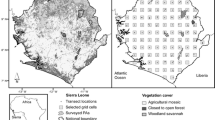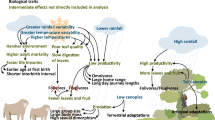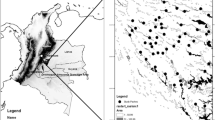Abstract
Species-area relationships predict that there is a positive relationship between the number of species and the size of an area. It has been suggested that species richness will covary with area because larger areas have a greater diversity of habitats. Moreover, habitat diversity may operate in conjunction with riverine barriers to influence primate biogeography. Few studies have determined if and how these hypotheses relate to primate diversity in Guyana. To test these biogeographic hypotheses, I used data from 1,725 km of primate surveys I conducted in Guyana. I estimated geographic ranges for each of the 8 primate species via a GIS system. Geographic range size is a major determinant of the number of sightings of the 8 primate species. Primate species diversity is strongly negatively correlated with the number of rivers crossed moving in a clockwise pattern from eastern to NW Guyana. Interfluvial and habitat areas influence primate species diversity in Guyana. However, my data on primate biogeography in Guyana do not support the hypothesis that habitat diversity within the interfluvial areas effects primate diversity. Although the species-area relationship is considered the closest thing to a rule in ecology, researchers should be wary of too readily applying and accepting the model at all scales in biogeographic studies.
Similar content being viewed by others

Reference
Anderson, D. R., Laake, J. L., Crain, B. R., and Burnham, K. P. (1979). Guidelines for line transect sampling of biological populations. J. Wild Manag. 43: 70-78.
Arita, H. T., Robinson, J. G., and Redford, K. H. (1990). Rarity in Neotropical forest mammals and its ecological correlates. Cons. Biol. 4: 181-192.
Ayres, J. M. (1986). Uakaries and Amazonian Flooded Forests, Unpublished PhD Thesis, Cambridge University, Cambridge, England.
Ayres, J. M., and Clutton-Brock, T. H. (1992). River boundaries and species range size in Amazonian primates. Amer. Nat. 140: 531-537.
Barnett, A., Shapely, B., Lehman, S. M., Mayor, M., Henry, E., Benjamin, P., McGarrill, M., and Nagala, R. (2000). Primate records from the Potaro Plateau, western Guyana. Neotrop. Prim. 8: 35-40.
Bates, J. M., Hackett, S. J., and Cracraft, J. (1998). Area-relationships in the Neotropical lowlands: an hypothesis based on raw distributions of Passerine birds. J. Biogeog. 25: 783-793.
Bennett, C. L., Leonard, S., and Carter, S. (2001). Abundance, diversity, and patterns of distribution of primates on the Tapiche River in Amazonian Peru. Am. J. Primatol. 54: 119-126.
Boggan, J., Funk, V., Kelloff, C., Hoff, M., Cremers, G., and Feuillet, C. (1997). Checklist of the Plants of the Guianas (Guyana, Surinam, French Guiana), Biological Diversity of the Guianas Program, Washington, DC.
Buckland, S. T., Burnham, K. P., Anderson, D. R., and Laake, J. L. (1993). Density Estimation Using Distance Sampling, Chapman and Hall, London, England.
Clarke, H. D., Funk, V. A., and Hollowell, T. (2001). A comparative checklist of the plant divssersity of the Iwokrama Forest, Guyana. Sida, Bot. Miscell. 21: 1-93.
Colyn, M. M. (1988). Distribution of guenons in the Zaire–Lualaba–Lomani river system. In Gautier-Hion, A., Bourliere, F., Gautier, J. P., and Kingdon, J. (eds.): A Primate Radiation: Evolutionary Biology of the African Guenons, University of Cambridge Press, Cambridge, pp. 104-124.
Comiskey, J., Dallmeier, F., Aymard, G., and Hanson, A. (1993). Biodiversity Survey of Kwakwani, Guyana, The Smithsonian Institution/Man and the Biosphere Biological Diversity Program, Washington, DC.
Cowlishaw, G., and Dunbar, R. (2000). Primate Conservation Biology, University of Chicago Press, Chicago.
Cowlishaw, G., and Hacker, J. E. (1997). Distribution, diversity, and latitude in African primates. Amer. Nat. 150: 505-512.
Cropp, S. J., Larson, A., and Cheverud, J. M. (1999). Historical biogeography of tamarins, genus Saguinus: The molecular phylogenetic evidence. Am. J. Phys. Anthropol. 108: 65-89.
Da Silva, J. M. C., and Oren, D. C. (1996). Application of parsimony analysis of endemicity in Amazonian biogeography: an example with primates. Biol. J. Linn. Soc. 59: 427-437.
Davis, T. A., and Richards, P. W. (1934). The vegetation of Moraballi Creek, British Guiana: An ecological study of a limited tropical rain forest. J. Ecol. 22: 106-155.
de Granville, J.-J. (1988). Phytogeographical characteristics of the Guianan forests. Taxon 37: 578-594.
Eden, M. (1964). The savanna ecosystem—northern Rupununi, British Guiana, McGill University, Montreal.
Eeley, H., and Lawes, M. (1999). Large-scale patterns of species richness and species range size in African and South American primates. In Fleagle, J. G., Janson, C. H., and Reed, K. (eds.): Primate Communities, Cambridge University Press, Cambridge, pp. 191-219.
Eeley, H. A. C., and Laws, M. J. (1999). Large-scale patterns of species richness and species range size in anthropoid primates. In Fleagle, J. G., Janson, C. H., and Reed, K. (eds.): Primate Communities, Cambridge University Press, Cambridge, pp. 191-219.
Fleagle, J. G., and Mittermeier, R. A. (1980). Locomotor behavior, body size, and comparative ecology of seven Surinam monkeys. Am. J. Phys. Anthropol. 52: 301-314.
Fleagle, J. G., and Reed, K. E. (1996). Comparing primate communities: A multivariate approach. J. Hum. Evol. 30: 489-510.
Ganzhorn, J. U. (1994). Lemurs as indicators for habitat change. In Thierry, B., Anderson, J. R., Roeder, J. J., and Herrenschmidt, N. (eds.), Current Primatology, Vol. 1: Ecology and Evolution, University of Louis Pasteur, Strasbourg, pp. 51-56.
Hanski, I., Kouki, J., and Halkka, A. (1993). Three explanations of the positive relationship between distribution and abundance of species. In Ricklefs, R. E., and Schluter, D. (eds.), Species Diversity in Ecological Communities: Historical and Geographical Perspectives, University of Chicago Press, Chicago, pp. 108-116.
Henkel, T. (1994). Expedition Reports, Smithsonian Institution Department of Botany.
Hershkovitz, P. (1963). A systematic and zoogeographic account of the monkeys of the genus Callicebus (Cebidae) of the Amazonas and Orinoco river basins. Mammalia 27: 1-76.
Hershkovitz, P. (1968). Metachromism or the principle of evolutionary change in mammalian tegumentary colors. Evolution 22: 556-575.
Hershkovitz, P. (1977). Living New World Monkeys (Platyrrhini) With an Introduction to Primates, University of Chicago Press, Chicago.
Hill, J. L., Curran, P. J., and Foody, G. M. (1994). The effect of sampling on the species-area curve. Glob. Ecol. Biog. Let. 4: 97-106.
Hoffman, B. (1992). Expedition Reports, Smithsonian Institution Department of Botany.
Huber, O., Funk, V., and Gharbarran, G. (1995). Vegetation Map of Guyana, Centre for the Study of Biological Diversity, Georgetown.
Iwanaga, S., and Ferrari, S. F. (2002). Geographic distribution and abundance of woolly (Lagothrix cana) and spider (Ateles chamek) monkeys in southwestern Brazilian Amazonia. Am. J. Primatol. 56: 57-64.
Janson, C. H. (1987). Ecological correlates of aggression in brown capuchin monkeys. Int. J. Primatol. 8: 431-431.
Johns, A. D., and Skorupa, J. P. (1987). Responses of rain-forest primates to habitat disturbance: a review. Int. J. Primatol. 8: 157-191.
Kay, R. F., Madden, R. H., van Schaik, C., and Higdon, D. (1997). Primate species richness is determined by plant productivity: Implications for conservation. Proc. Natl. Acad. Sci. U.S.A. 94: 13023-13027.
Kiltie, R. (1980). Seed Predation and Group Size in Rain Forest Peccaries, PhD Thesis, Princeton University.
Kinzey, W. G., Norconk, M. A., and Alvarez-Cordero, E. (1988). Primate survey of eastern Bolivar, Venezuela. Primate Conserv. 9: 66-70.
Krebs, C. J. (1989). Ecological Methodology, Harper Collins, New York.
Laws, M. J., and Eeley, H. A. C. (2000). Are local patterns of anthropoid primate diversity related to patterns of diversity at larger scale? J. Biogeog. 27: 1421-1435.
Lehman, S. M. (1999). Biogeography of the Primates of Guyana, Unpublished PhD Dissertation, Washington University, St. Louis, MO.
Lehman, S. M. (2000). Primate community structure in Guyana: A biogeographic analysis. Int. J. Primatol. 21: 333-351.
Lehman, S. M., Sussman, R. W., Phillips-Conroy, J., and Prince, W. (in press). Ecological biogeography of primates in Guyana: The effects of natural and anthropogenic disturbances. In Lehman, S. M., and Fleagle, J. G. (eds.), Primate Biogeography, Plenum/Kluwer Press, New York.
MacArthur, R. H., and Wilson, E. O. (1967). The Theory of Island Biogeography, Princeton University Press, Princeton.
Maguire, B. (1972). The botany of the Guayana higland, IX (Plant Taxonomy). Mem. N.Y. Bot. Gardens 23: 1-832.
Maguire, B., Cowan, R. S., and Wurdack, J. J. (1953). The botany of the Guayana highland. Mem. N.Y. Bot. Gardens 8: 87-96.
Mittermeier, R. A. (1977). Distribution, Synecology, and Conservation of Surinam Monkeys, PhD Dissertation, Harvard University, Boston, MA.
Muckenhirn, N. A., Mortenson, B. K., Vessey, S., Fraser, C. E. O., and Singh, B. (1975). Report of a Primate Survey in Guyana, Pan American Health Organization.
Norconk, M. A., Sussman, R. W., and Phillips-Conroy, J. (1997). Primates of Guayana Shield Forests: Venezuela and the Guianas. In Norconk, M. A., Rosenberger, A. L., and Garber, P. A. (eds.) Adaptive Radiations of Neotropical Primates, Plenum Press, New York, pp. 69-86.
Parker, T. A. I., Foster, R. B., Emmons, L., Freed, P., Forsyth, A., Hoffman, B., and Gill, B. D. (1993). A Biological Assessment of the Kanuku Mountain Region of Southwestern Guyana, Conservation International.
Peres, C. (1990). Effects of hunting on western Amazonian primate communities. Biol. Cons. 54: 47-59.
Peres, C. (1993). Notes on the primates of the Jaruá River, western Brazilian Amazonia. Folia. Primatol. 61: 97-103.
Peres, C. A. (1997). Primate community structure at twenty western Amazonian flooded and unflooded forests. J. Trop. Ecol. 13: 381-405.
Peres, C. A. (1999). General guidelines for standardizing line-transect surveys of tropical forest primates. Neotrop. Prim. 7: 11-16.
Peres, C. A., and Janson, C. H. (1999). Species coexistence, distribution, and environmental determinants of neotropical primate richness: A community-level zoogeographic analysis. In Fleagle, J. G., Janson, C. H., and Reed, K. (eds.): Primate Communities, Cambridge University Press, New York, pp. 55-74.
Peres, C. A., Patton, J. L., and da Silva, M. N. (1996). Riverine barriers and gene flow in Amazonian saddle-back tamarins. Folia Primatol. 67: 113-124.
Plotkin, J. B., Potts, M. D., Lesliea, N., Manokarane, N., Lafrankieb, J., and Ashton, P. S. (2000). Species-area curves, spatial aggregation, and habitat specialization in tropical forests. J. Theor. Biol. 207: 81-99.
Preston, F. W. (1962). The canonical distribution of commonness and rarity. Ecologia 43: 185-215.
Rafe, R. W., Usher, M. B., and Jefferson, R. G. (1985). Birds on reserves: the influence of area and habitat on species richness. J. Appl. Ecol. 22: 327-335.
Reed, K. E., and Fleagle, J. G. (1995). Geographic and climate control of primate diversity. Proc. Nat. Acad. Sci. U.S.A. 92: 7874-7876.
Robinson, J. G., and Bennett, E. L. (eds.). (2000). Hunting for Sustainability in Tropical Forests, Columbia University Press, New York.
Ron, S. R. (2000). Biogeographic area relationships of lowland neotropical rainforest based on raw distributions of vertebrate groups. Biol. J. Linn. Soc. 71: 379-402.
Rosenzweig, M. L. (1995). Species Diversity in Space and Time, Cambridge University Press, Cambridge.
Rowe, N. (1996). The Pictorial Guide to the Living Primates, Pogonias Press, East Hampton.
Salo, J., Kalliola, R., Hakkinen, I., Makinen, Y., Niemela, P., Puhakka, M., and Coley, P. (1986). River dynamics of Amazon lowland forest. Nature 322: 254-258.
Skorupa, J. P. (1986). Responses of rainforest primates to selective logging in Kibale Forest, Uganda: A summary report. InBenirschke, K. (ed.), Primates: The Road to Self-Sustaining Populations, Springer-Verlag, New York, pp. 57-70.
Smith, R. J., and Jungers, W. L. (1997). Body mass in comparative primatology. J. Hum. Evol. 32: 523-559.
Stevens, G. C. (1989). The latitudinal gradient in geographic range: How so many species coexist in the tropics. Amer. Nat. 133: 240-246.
Sussman, R. W., and Phillips-Conroy, J. (1995). A survey of the distribution and diversity of the primates of Guyana. Int. J. Primatol. 16: 761-792.
ter Steege, H. (1993a). A Monograph of Wallaba, Mora, and Greenheart, Stichting Tropenbos, Wageningen.
ter Steege, H. (1993b). Patterns in Tropical Rain Forest in Guyana, Stichting Tropenbos, Wageningen.
Terborgh, J. (1983). Five New World Primates: A Study in Comparative Ecology, Princeton University Press, Princeton.
Terborgh, J. (1986). Keystone plant resources in the tropical forests. In Soule, M. E. (ed.), Conservation Biology: The Science of Scarcity and Diversity, Sinauer, Sunderland, MA, pp. 330-344.
Terborgh, J., and Andresen, E. (1998). The composition of Amazonian forests: Patterns at local and regional scales. J. Trop. Ecol. 14: 645-664.
Terborgh, J., and Janson, C. H. (1986). The socioecology of primate groups. Ann. Rev. Ecol. Syst. 17: 111-136.
Thiollay, J. M. (1994). Structure, density, and rarity in an Amazonian rainforest bird community. J. Trop. Ecol. 10: 449-481.
UNESCO (1985). Discharge of Selected Rivers of the World, Santype International Ltd, Salisbury.
van Roosmalen, M. G. M. (1985a). Fruits of the Guianan Flora, Utrecht University, Utrecht.
van Roosmalen, M. G. M. (1985b). Habitat preferences, diet, feeding strategy and social organization of the black spider monkey (Ateles paniscus paniscus Linnaeus 1758) in Surinam. Acta Amazon. 15: 1-238.
Wallace, R. B., Painter, R. L. E., Taber, A. B., and Ayres, J. M. (1996). Notes on a distributional river boundry and southern range extension for two species of Amazonian primate. Neotrop. Prim. 4: 10-13.
Williams, C. B. (1964). Patterns in the Balance of Nature and Related Problems in Quantitative Ecology, Academic Press, New York.
Wolfheim, J. C. (1983). Primates of the World: Distribution, Abundance, and Conservation, University of Washington Press, Seattle.
Yiming, L., Niemela, J., and Dianmo, L. (1998). Nested distribution of amphibians in the Zhoushan archipelago, China: Can selective extinction cause nested subsets of species? Oecologia 113: 557-564.
Author information
Authors and Affiliations
Rights and permissions
About this article
Cite this article
Lehman, S.M. Distribution and Diversity of Primates in Guyana: Species-Area Relationships and Riverine Barriers. International Journal of Primatology 25, 73–95 (2004). https://doi.org/10.1023/B:IJOP.0000014646.82182.51
Issue Date:
DOI: https://doi.org/10.1023/B:IJOP.0000014646.82182.51



